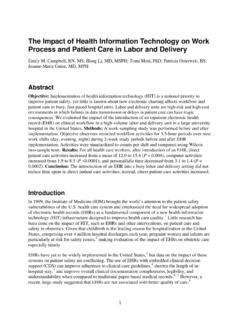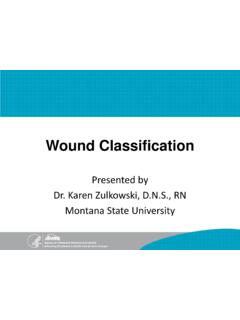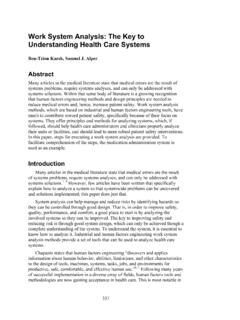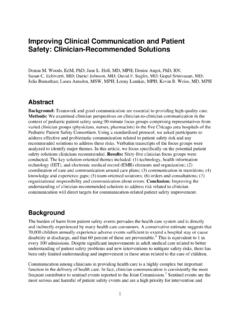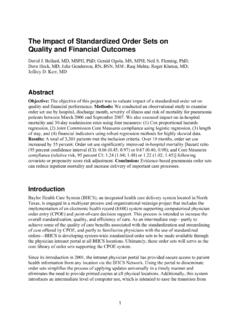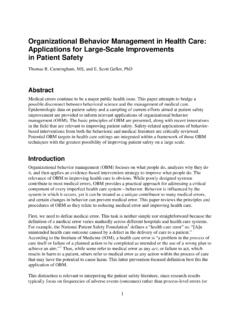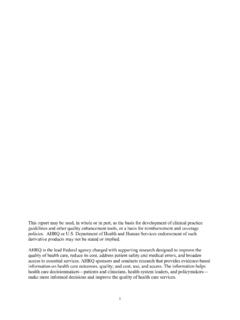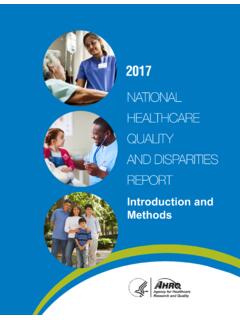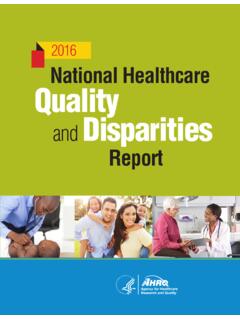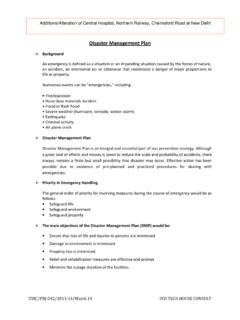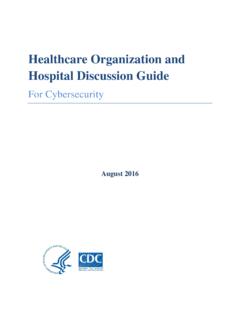Transcription of Care Transitions from Hospital to Home: IDEAL Discharge ...
1 Strategy 4: IDEAL Discharge Planning (Implementation Handbook) Guide to Patient and Family Engagement Care Transitions from Hospital to Home: IDEAL Discharge Planning Implementation Handbook Strategy 4: IDEAL Discharge Planning (Implementation Handbook) Guide to Patient and Family Engagement :: i Table of Contents Introduction ---------------------------------------- ---------------------------------------- -------------------------------- 1 Overview of the IDEAL Discharge Planning strategy-------------------------------- ---------------------------------- 1 What are the IDEAL Discharge Planning tools?---------------------------------- ---------------------------------------5 What is the IDEAL Discharge Planning process? ---------------------------------------- ------------------------------ 6 What are the resources needed?
2 ---------------------------------------- ---------------------------------------- ---------- 7 Rationale for the IDEAL Discharge Planning Strategy ---------------------------------------- --------------- 8 What is the evidence for improving Discharge planning? ---------------------------------------- -------------------- 8 What are the key challenges related to Discharge ? ---------------------------------------- --------------------------- 9 How to prevent adverse events after Discharge ---------------------------------------- ------------------------------ 11 How does the IDEAL Discharge Planning strategy improve the Discharge process? ---------------------------- 12 How does engaging the patient and family differ from a typical Discharge process? --------------------------- 12 Implementing the IDEAL Discharge Planning Strategy ---------------------------------------- ----------- 14 Step 1: Form a multidisciplinary team to identify areas of improvement ---------------------------------------- - 14 Engage patients and families and unit staff in the process.
3 Establish a multidisciplinary team ---------- 14 Assess family visitation policies ---------------------------------------- ---------------------------------------- ---- 15 Assess current views on the Discharge process, including how patients and family members are engaged ---------------------------------------- ---------------------------------------- ------------------------------- 15 Recognize challenges in changing staff behavior-------------------------------- -------------------------------- 16 Set aims to improve Discharge planning ---------------------------------------- ---------------------------------- 17 Step 2: Decide on how to implement the IDEAL Discharge Planning strategy ---------------------------------- 18 Decide on how to adapt the IDEAL Discharge Planning process for your Hospital ------------------------- 18 Step 3.
4 Implement and evaluate the IDEAL Discharge Planning strategy ---------------------------------------- 20 Inform staff of changes ---------------------------------------- ---------------------------------------- -------------- 20 Train staff ---------------------------------------- ---------------------------------------- ----------------------------- 20 Distribute tools and incorporate key principles into practice ---------------------------------------- ---------- 21 Assess implementation intensely during the first month and periodically after that ---------------------- 21 Get feedback from nurses, patients, and families ---------------------------------------- ----------------------- 21 Refine the process ---------------------------------------- ---------------------------------------- ------------------- 21 Case Study on IDEAL Discharge Planning: Advocate Trinity Hospital ------------------------------- 22 References ---------------------------------------- ---------------------------------------- ------------------------------- 24 Strategy 4: IDEAL Discharge Planning (Implementation Handbook) Guide to Patient and Family Engagement.
5 1 Introduction The Guide to Patient and Family Engagement in Hospital Quality and Safety is a resource to help hospitals develop effective partnerships with patients and family members with the ultimate goal of improving multiple aspects of Hospital quality and safety.* Discharge from Hospital to home requires the successful transfer of information from clinicians to the patient and family to reduce adverse events and prevent readmissions. Engaging patients and families in the Discharge planning process helps make this transition in care safe and effective. This handbook gives an overview of and rationale for the IDEAL Discharge Planning strategy. It also provides step-by-step guidance to help you put this strategy into place at your Hospital and addresses common challenges.
6 Throughout this handbook, we include examples and real-world experiences from Advocate Trinity Hospital in Chicago, IL, which implemented IDEAL Discharge Planning as part of a year-long pilot project. Interested in improving Transitions from Hospital to home? Read this handbook for detailed instructions on how to adapt and implement the IDEAL Discharge Planning strategy at your Hospital . Overview of the IDEAL Discharge Planning s trategy The goal of the IDEAL Discharge Planning strategy is to engage patients and family members in the transition from Hospital to home, with the goal of reducing adverse events and preventable readmissions. The IDEAL Discharge Strategy can be used on its own or in conjunction with other initiatives, including RED (Re-engineering Discharge ), the Care Transitions program, and BOOSTing (Better Outcomes for Older Adults Through Safe Transitions ) Care Transitions .
7 *The Guide was developed for the Department of Health and Human Services Agency for Healthcare Research and Quality by a collaboration of partners with experience in and commitment to patient and family engagement, Hospital quality, and safety. Led by the American Institutes for Research, the team included the Institute for Patient and Family-Centered Care, Consumers Advancing Patient Safety, the Joint Commission, and the Health Research and Educational Trust. Other organizations contributing to the project included Planetree, the Maryland Patient Safety Center, Aurora Health Care, and Emory University Hospital . Strategy 4: IDEAL Discharge Planning (Implementation Handbook) Guide to Patient and Family Engagement :: 2 The IDEAL Discharge Planning strategy highlights the key elements of engaging the patient and family in Discharge planning.
8 Include the patient and family as full partners in the Discharge planning process Discuss with the patient and family five key areas to prevent problems at what life at home will be warning signs and test followup appointmentsEducate the patient and family in plain language about the patient s condition,the Discharge process, and next steps at every opportunity throughout the Hospital stay Assess how well doctors and nurses explain the diagnosis, condition, and nextsteps in the patient s care to the patient and family and use teach back. Listen to and honor the patient and family s goals, preferences, observations, andconcerns. Components of each IDEAL element are described in more detail on the following pages. Strategy 4: IDEAL Discharge Planning (Implementation Handbook) Guide to Patient and Family Engagement :: 3 Include the patient and family as full partners in the dischargeplanning process.
9 Always include the patient and family in team meetings aboutdischarge. Remember that Discharge is not a one-time event but is aprocess that takes place throughout the Hospital stay. Identify which family members or friends will provide care at home andinclude them in with the patient and family five key areas to preventproblems at home. what life at home will be like. Include homeenvironment, support needed, what the patient can orcannot eat, and activities to do or medications. Use a reconciled medication list todiscuss the purpose of each medicine, how much to take,how to take it, and potential side Highlight warning signs and problems. Identifywarning signs or potential problems. Write down thename and contact information of someone to call if thereis a test results.
10 Explain test results to the patientand family. If test results are not available at Discharge , letthe patient and family know when they should hear aboutresults and identify who they should call if they have notheard the results by that followup appointments. Offer to make followupappointments for the patient. Make sure that the patientand family know what followup is 4: IDEAL Discharge Planning (Implementation Handbook) Guide to Patient and Family Engagement :: 4 Educate the patient and family in plain language about the patient scondition, the Discharge process, and next steps at every opportunity throughout the Hospital stay. Getting all the information about a condition and next steps on the day of Discharge can be overwhelming. Discharge planning should be an ongoing process throughout the stay, not a one-time event.

